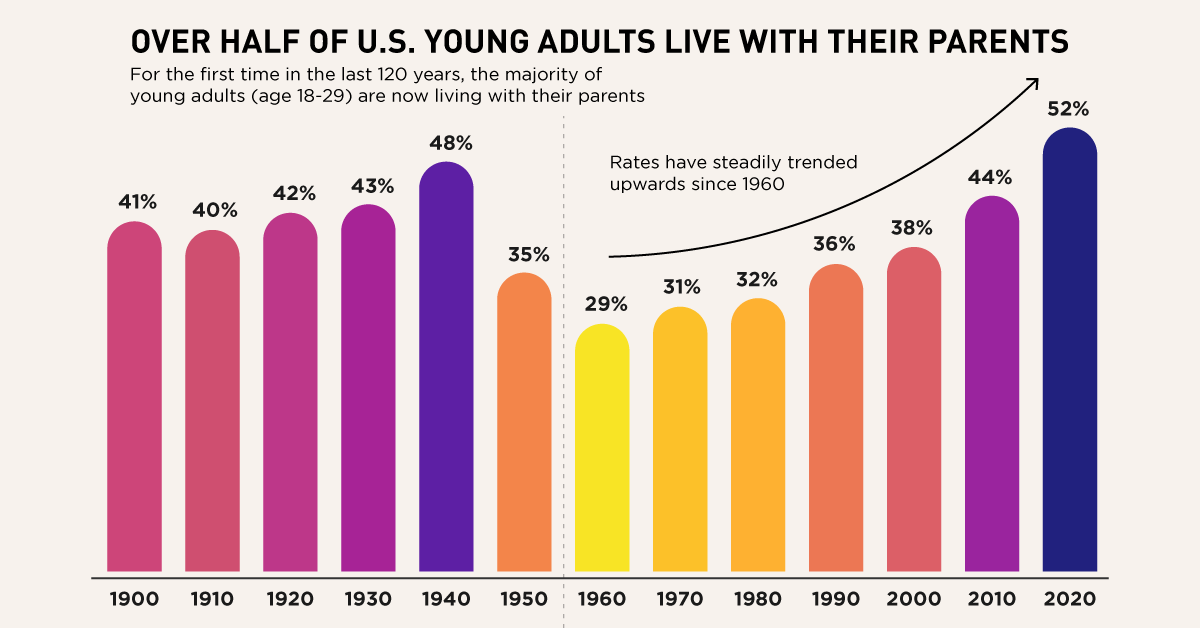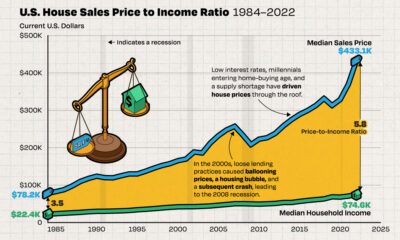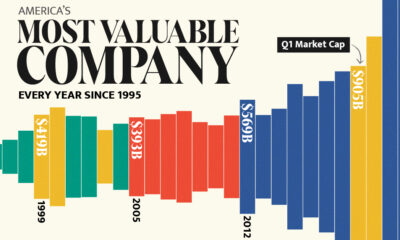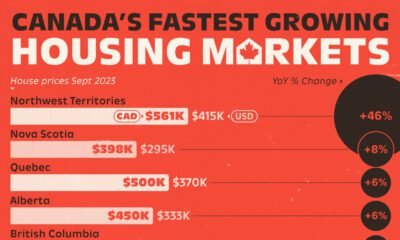Datastream
Over Half of U.S. Young Adults Now Live With Their Parents
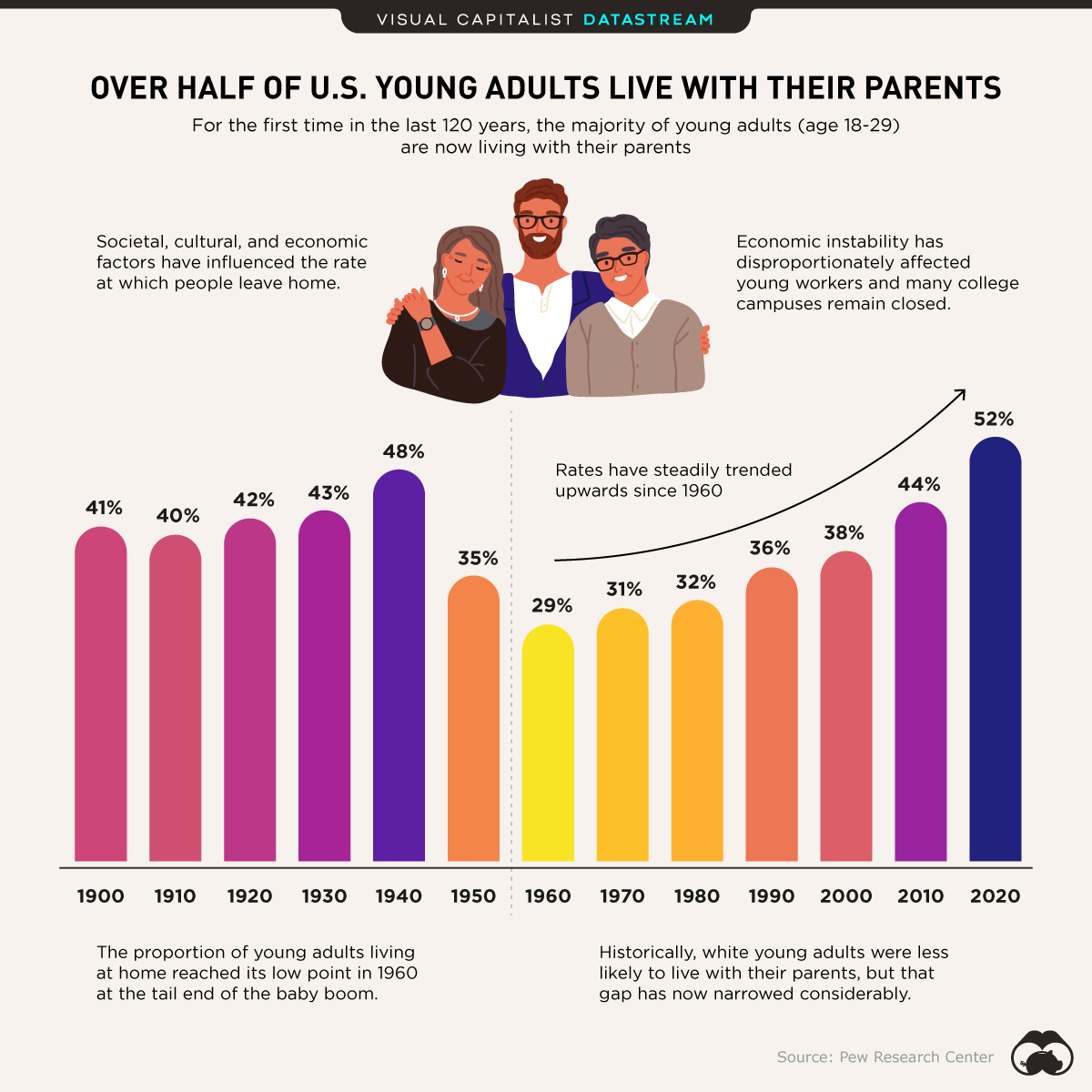
The Briefing
- Since 1900, the portion of young adults living with their parents has ranged from 29-52%
- These numbers have steadily increased since 1960
- In 2020, the majority of U.S. adults aged 18-29 live with their parents
Over Half of U.S. Young Adults Live With Their Parents
In the last few decades, young adults have faced harsh economic realities—from the financial crisis in 2008 to this year’s global pandemic, both triggering catastrophic losses in jobs and financial stability.
And while the widespread effects of COVID-19 have yet to be fully captured, young adults are already now living with their parents to a greater degree than witnessed in 120 years—surpassing even the Depression-era generation.
| Decade | % Of Young Adults (18-29) Living With Their Parents |
|---|---|
| 1900 | 41% |
| 1910 | 40% |
| 1920 | 42% |
| 1930 | 43% |
| 1940 | 48% |
| 1950 | 35% |
| 1960 | 29% |
| 1970 | 31% |
| 1980 | 32% |
| 1990 | 36% |
| 2000 | 38% |
| 2010 | 44% |
| 2020 | 52% |
Young adults today are categorized as either late Millennials and Gen-Zers. For them, COVID-19 has just been another addition to the list of financial hardships they’ve been up against, such as a precarious job market and the rising cost of living.
Failure to Launch: But Why?
There are a few possible factors that could explain the increase in young adults living with their parents.
1. The lackluster job market
The barista or server with multiple degrees has become a common portrayal of the struggling millennial. Despite the less than rosy outcomes, it has not been for want of trying. Younger people today are actually the most educated generation in history. Unfortunately, a degree does not map out a path to success the way it did for prior generations.
2. Tying the knot later
Today, people get married nearly a decade later than prior historical averages, and many young adults are opting to stay with their parents until they tie the knot. It’s also worth noting that as time goes on, young adults are getting married at lower rates than in the past.
Where does this data come from?
Source: Pew Research Center
Notes: This data was released on September 4, 2020
Datastream
Can You Calculate Your Daily Carbon Footprint?
Discover how the average person’s carbon footprint impacts the environment and learn how carbon credits can offset your carbon footprint.

The Briefing
- A person’s carbon footprint is substantial, with activities such as food consumption creating as much as 4,500 g of CO₂ emissions daily.
- By purchasing carbon credits from Carbon Streaming Corporation, you can offset your own emissions and fund positive climate action.
Your Everyday Carbon Footprint
While many large businesses and countries have committed to net-zero goals, it is essential to acknowledge that your everyday activities also contribute to global emissions.
In this graphic, sponsored by Carbon Streaming Corporation, we will explore how the choices we make and the products we use have a profound impact on our carbon footprint.
Carbon Emissions by Activity
Here are some of the daily activities and products of the average person and their carbon footprint, according to Clever Carbon.
| Household Activities & Products | CO2 Emissions (g) |
|---|---|
| 💡 Standard Light Bulb (100 watts, four hours) | 172 g |
| 📱 Mobile Phone Use (195 minutes per day)* | 189 g |
| 👕 Washing Machine (0.63 kWh) | 275 g |
| 🔥 Electric Oven (1.56 kWh) | 675 g |
| ♨️ Tumble Dryer (2.5 kWh) | 1,000 g |
| 🧻 Toilet Roll (2 ply) | 1,300 g |
| 🚿 Hot Shower (10 mins) | 2,000 g |
| 🚙 Daily Commute (one hour, by car) | 3,360 g |
| 🍽️ Average Daily Food Consumption (three meals of 600 calories) | 4,500 g |
| *Phone use based on yearly use of 69kg per the source, Reboxed | |
Your choice of transportation plays a crucial role in determining your carbon footprint. For instance, a 15 km daily commute to work on public transport generates an average of 1,464 g of CO₂ emissions. Compared to 3,360 g—twice the volume for a journey the same length by car.
By opting for more sustainable modes of transport, such as cycling, walking, or public transportation, you can significantly reduce your carbon footprint.
Addressing Your Carbon Footprint
One way to compensate for your emissions is by purchasing high-quality carbon credits.
Carbon credits are used to help fund projects that avoid, reduce or remove CO₂ emissions. This includes nature-based solutions such as reforestation and improved forest management, or technology-based solutions such as the production of biochar and carbon capture and storage (CCS).
While carbon credits offer a potential solution for individuals to help reduce global emissions, public awareness remains a significant challenge. A BCG-Patch survey revealed that only 34% of U.S. consumers are familiar with carbon credits, and only 3% have purchased them in the past.
About Carbon Streaming
By financing the creation or expansion of carbon projects, Carbon Streaming Corporation secures the rights to future carbon credits generated by these sustainable projects. You can then purchase these carbon credits to help fund climate solutions around the world and compensate for your own emissions.
Ready to get involved?
>> Learn more about purchasing carbon credits at Carbon Streaming
-

 Debt1 week ago
Debt1 week agoHow Debt-to-GDP Ratios Have Changed Since 2000
-

 Markets2 weeks ago
Markets2 weeks agoRanked: The World’s Top Flight Routes, by Revenue
-

 Countries2 weeks ago
Countries2 weeks agoPopulation Projections: The World’s 6 Largest Countries in 2075
-

 Markets2 weeks ago
Markets2 weeks agoThe Top 10 States by Real GDP Growth in 2023
-

 Demographics2 weeks ago
Demographics2 weeks agoThe Smallest Gender Wage Gaps in OECD Countries
-

 United States2 weeks ago
United States2 weeks agoWhere U.S. Inflation Hit the Hardest in March 2024
-

 Green2 weeks ago
Green2 weeks agoTop Countries By Forest Growth Since 2001
-

 United States2 weeks ago
United States2 weeks agoRanked: The Largest U.S. Corporations by Number of Employees




